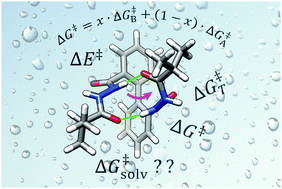Counterintuitive torsional barriers controlled by hydrogen bonding†
Abstract
The torsional barriers along the Caryl–Caryl axis of a pair of isosteric disubstituted biphenyls were determined by variable temperature 1H NMR spectroscopy in three solvents with contrasted hydrogen bond accepting abilities (1,1,2,2-tetrachloroethane-d2, nitrobenzene-d5 and dimethyl sulfoxide-d6). One of the biphenyl scaffolds was substituted at its ortho and ortho′ positions with N′-acylcarbohydrazide groups that could engage in a pair of intramolecular N–H⋯O=C hydrogen bonding interactions at the ground state, but not at the transition state of the torsional isomerization pathway. The torsional barrier of this biphenyl was exceedingly low despite the presence of the hydrogen bonds (16.1, 15.6 and 13.4 kcal mol−1 in the three aforementioned solvents), compared to the barrier of the reference biphenyl (15.3 ± 0.1 kcal mol−1 on average). Density functional theory and the solvation model developed by Hunter were used to decipher the various forces at play. They highlighted the strong stabilization of hydrogen bond donating solutes not only by hydrogen bond accepting solvents, but also by weakly polar, yet polarizable solvents. As fast exchanges on the NMR time scale were observed above the melting point of dimethyl sulfoxide-d6, a simple but accurate model was also proposed to extrapolate low free activation energies in a pure solvent (dimethyl sulfoxide-d6) from higher ones determined in mixtures of solvents (dimethyl sulfoxide-d6 in nitrobenzene-d5).



 Please wait while we load your content...
Please wait while we load your content...